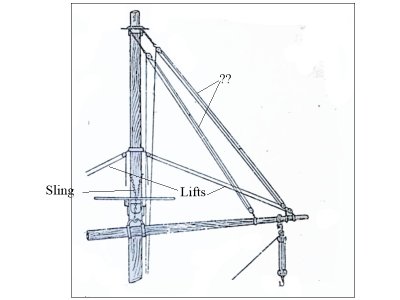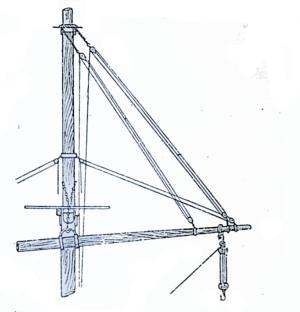-

Win a Free Custom Engraved Brass Coin!!!
As a way to introduce our brass coins to the community, we will raffle off a free coin during the month of August. Follow link ABOVE for instructions for entering.
You are using an out of date browser. It may not display this or other websites correctly.
You should upgrade or use an alternative browser.
You should upgrade or use an alternative browser.
Ciao Elmaship,
Can you say what ship/nation/era this rig is for? Also is this a lower yard or topsail yard? The rigging varied a lot depending on the era, but I cannot find any information based on contemporary sources showing rigging like in your sketch.
The main supports were jeers and slings. Lifts contributed, but the primary purpose of the lifts was to keep the yardarms level or at a specific angle when the sail was being set or furled as the yards lowered. I marked the sling, but there is no jeer on your drawing. The jeers were often removed once the yard was in place, so that may be why it is missing.
What are the lines with the question mark below? They look like lifts for a topsail yard but there is already the lift that would be for the lower yard. Also, there are two which is unusual.
As there are chain slings I am assuming the ship is after about 1760 so would have had truss pendants, but they appear to be missing on the drawing.
Sorry not to be more helpful.
Allan

Can you say what ship/nation/era this rig is for? Also is this a lower yard or topsail yard? The rigging varied a lot depending on the era, but I cannot find any information based on contemporary sources showing rigging like in your sketch.
The main supports were jeers and slings. Lifts contributed, but the primary purpose of the lifts was to keep the yardarms level or at a specific angle when the sail was being set or furled as the yards lowered. I marked the sling, but there is no jeer on your drawing. The jeers were often removed once the yard was in place, so that may be why it is missing.
What are the lines with the question mark below? They look like lifts for a topsail yard but there is already the lift that would be for the lower yard. Also, there are two which is unusual.
As there are chain slings I am assuming the ship is after about 1760 so would have had truss pendants, but they appear to be missing on the drawing.
Sorry not to be more helpful.
Allan

A similar drawing is found in Plate 72 from Text-Book of Seamanship, 1891, where the two tackles can be seen on a lower yard. These are loading tackles (burtons). They are certainly not sail rigging devices, as they are mounted on pendants. The reason for my request stems from a text I am preparing for a group of Italian modelers on the correspondence of Italian terms with English ones (when possible). In Italian nautical terminology, when a single tackle was added, in addition to the lift (amantiglio), this was called a falso amantiglio, false not effective
Thank you elmaship. Your project is admirable, congratulations. Thank you also for mentioning the Text Book of Seamanship 1891. I downloaded it and find it has a wealth of information. I just began to study it and hope to learn a lot.I am preparing for a group of Italian modelers on the correspondence of Italian terms with English ones (when possible).
Thanks again. For anyone interested..... https://maritime.org/doc/luce/index.php


